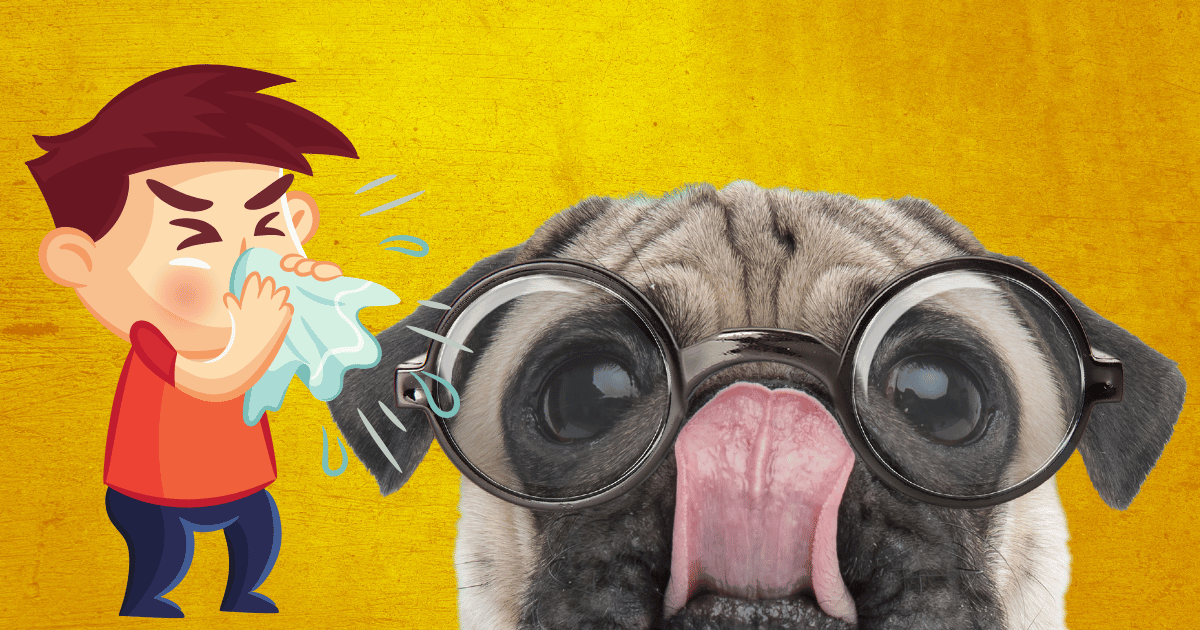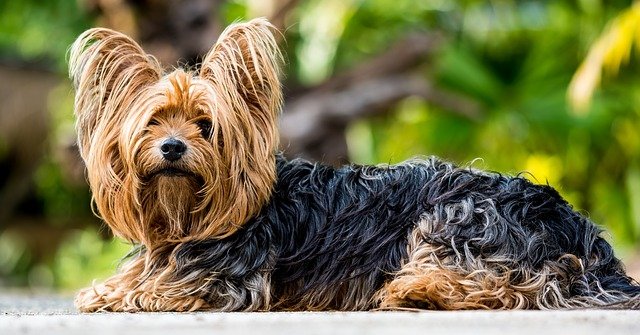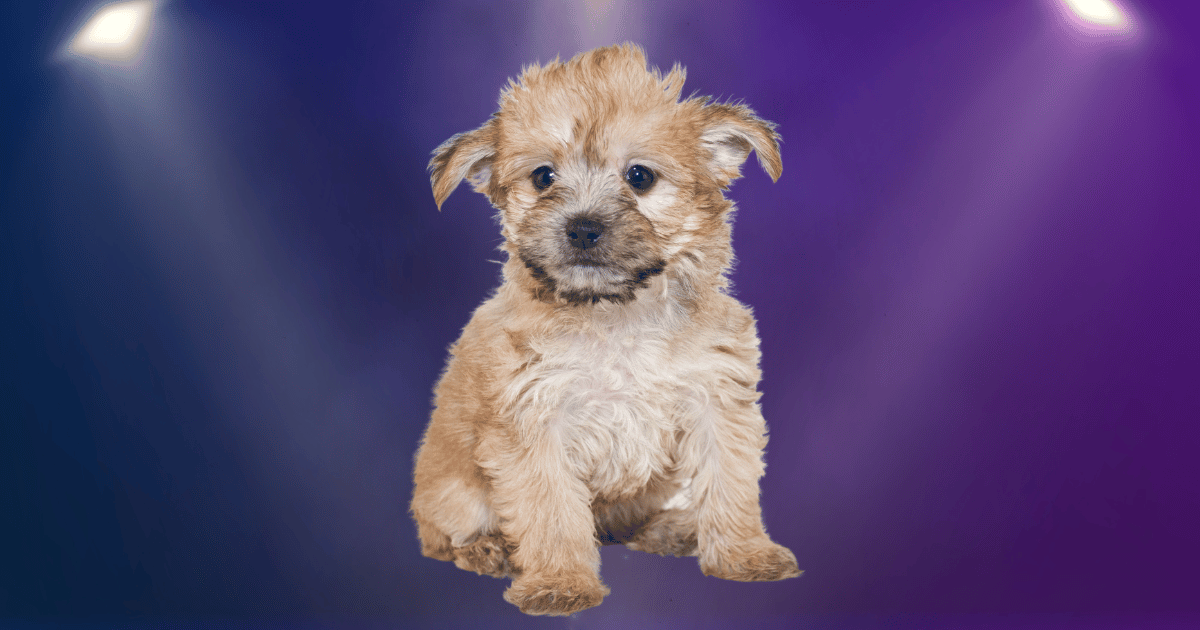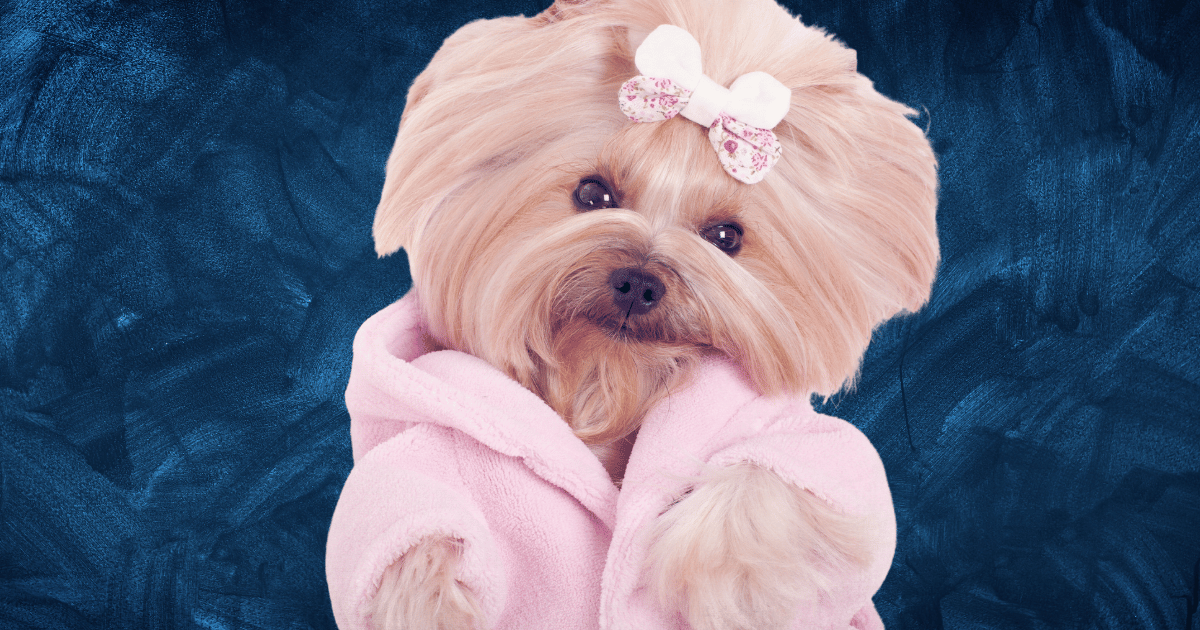It is a widespread belief that Yorkshire Terrier or Yorkies are a hypoallergenic dog breed.
This is because its unique coat (the Yorkie’s hair, a so called hypoallergenic coat) resembles human hair more than dog’s fur.
But if you ask me “are Yorkies hypoallergenic dogs?”, my answer is yes. Yorkies are hypoallergenic dogs.
Now, if you ask “are Yorkies 100% hypoallergenic dogs?”, “can i trust that i do not get allergic reactions at all?”, then my answer is no, Yorkies are not hypoallergenic dogs.
Let me explain…
This small size pup (have you seen Teacup Yorkies? OMG!! Adorable!) is NOT a hypoallergenic breed, and that is because when it comes to dog allergies, there is more than dog hair to blame!
The culprit behind human allergies to dogs lies in the allergy-causing proteins that dogs produce.
This protein is present in dog saliva, urine, and skin cells, so it is impossible to have a completely hypoallergenic dog.
There is no such thing.
The Yorkie is no exception, even with its human-like long hair dog.
But, let’s start by understanding pet allergies first…
What’s The Deal With Pet Allergies?

So, here’s the deal: a bunch of folks in the United States get the sniffles, sneezes, and itchy eyes thanks to our furry friends.
According to the Asthma and Allergy Foundation of America, between 15 to 30 percent of all Americans are affected by pet allergies.
That’s a pretty big chunk!
And get this, even if you don’t have a pet, you’re not off the hook.
The American Pet Products Association mentions that even households without pets can still have some of those pesky allergens floating around.
So, whether you’re a proud pet parent or just occasionally dog-sit for your neighbor, it’s good to know what might make you sneeze (and get a nice runny nose as a bonus 🤧)!
In the UK, allergies to pets, especially cats and dogs, are quite common. These allergies are particularly prevalent among individuals who also suffer from allergic asthma or hay fever.
A significant indicator of the widespread nature of pet allergies in the UK is the fact that pets are present in 59% of UK households. [Source: https://www.allergyuk.org/about-allergy/statistics-and-figures/]
In the Euro Zone, allergies to dogs are a notable concern. Studies have indicated that allergies to dogs and cats affect between 10% to 20% of the population.
For instance, sensitization to dogs in European school children was recorded at 8.7% in 1992.
Additionally, it’s estimated that around 26% of European adults who visit clinics for suspected allergies to inhalant allergens are sensitized to cats, and 27% to dogs.
Given the widespread ownership of pets across Europe, it’s essential for individuals to be informed and take necessary precautions if they have known or suspected dog allergies. [Sources: NCBI, Wiley Online Library].
Severity Of Allergic Reactions To Dogs
You know, when some folks say they’re allergic to dogs, they’re not just talking about a little sneeze here and there.
For some, it’s like their body throws a full-blown tantrum!
Their eyes get all watery and itchy, their nose runs like a leaky faucet, and they might even get some skin rashes.
It’s like their body’s way of saying, “Nope, not today!”
But here’s the kicker: for those with asthma, it can get even trickier. Imagine trying to breathe with a super tight feeling in your chest, like someone’s squeezing it.
Not fun, right?
That’s what can happen when their asthma gets triggered by a dog allergy.
And in rare cases, some folks might even experience anaphylaxis, which is a super severe allergic reaction.
It’s like the body goes into full panic mode, and it can be pretty scary.
That’s why it’s super important to know how you react around dogs, especially if you’re thinking of getting one.
Better safe than sneezy!
With all this and with so many dog owners and dog lovers out there, it makes sense, its a good idea to ask which dogs won’t make us sneeze, right?
This is why proper information (and education) on the best choice of hypoallergenic dog breeds is so important.
Let’s start with the most common questions…
What Are Hypoallergenic Dogs – What Makes Some Dogs Hypoallergenic?
We have established that the Yorkie is not hypoallergenic, but what exactly does “hypoallergenic” mean?
What are hypoallergenic dogs?
A “hypoallergenic” dog is a dog that is less likely to induce an allergic response in someone who has allergies to dogs (one of the most common pet allergies) compared to other breeds.
Common Misconceptions And The Myth Of 100% Hypoallergenic Dogs
Common misconceptions about hypoallergenic dogs often lead potential pet owners astray when choosing the right breed for their homes.
One of the most prevalent myths is that hypoallergenic dogs are entirely allergy-free.
In reality, no dog is 100% hypoallergenic.
Another widespread misconception is that it’s the dog’s hair or fur that causes allergic reactions.
While hair can carry allergens like dander, the primary culprits are often the allergy-causing proteins found in a dog’s saliva, urine, and dander.
Someone allergic to dogs has an immune system that recognizes these proteins as “invaders,” and it launches an immune response to flush the “invaders out of the body.
The body achieves this flushing through the symptoms allergy sufferers know too well – running noses, coughing, sneezing, etc.
Some people also mistakenly believe that regularly grooming or shaving the dog’s coat will entirely eliminate allergy risks.
While grooming can reduce the amount of dander a dog sheds, it doesn’t make the dog hypoallergenic.
It’s essential for potential dog owners to do thorough research and possibly spend time around the breed they’re considering to see if any allergic reactions occur before making a commitment.
Dander And Its Role In Dog Allergies
Dander, often mistaken for hair or fur, is actually tiny, even microscopic, flecks of skin shed by cats, dogs, and other animals with fur or feathers.
In addition to skin flakes, dander also contains proteins from urine, feces, and saliva of furry pets, and it’s these allergy-causing proteins that are the major culprits behind allergic reactions in sensitive individuals.
While all dogs shed dander, some breeds are labeled “hypoallergenic” because they tend to shed less dander than others.
However, it’s crucial to understand that no breed is entirely dander-free.
Dander can be found everywhere in the home – on furniture, bed linens, and even walls and ceilings.
Its lightweight and microscopic nature allow it to remain airborne for long periods, making it easily inhaled or ingested, leading to allergic reactions.
How Dander Triggers Allergic Reactions
When an individual with a pet allergy inhales or comes into contact with dander, their immune system identifies the proteins in dander as harmful invaders, similar to how it would react to harmful bacteria or viruses.
In response, the immune system produces antibodies to combat these perceived threats.
This reaction prompts the body to release histamines and other chemicals, which cause the symptoms of an allergic reaction.
Common symptoms include sneezing, runny or stuffy nose, itchy or watery eyes, and skin rashes.
For individuals with asthma, exposure to dander can exacerbate their symptoms, leading to wheezing, difficulty breathing, and other respiratory issues.
The body’s heightened response to these harmless proteins is what makes dander a primary concern for those with pet allergies.
Are Yorkies Hypoallergenic Dogs?
No, we cannot consider Yorkshire Terriers hypoallergenic dogs, although they produce fewer allergens than many other breeds (like the German Shepherd dog.)
So, at the end, what influences, what determines how hypoallergenic dog a Yorkie is?
Consider these characteristics as the determining factors…
The Yorkie’s Unique Coat – Yorkie’s Hair

The typical Yorkie has a long, silky coat that is single-layered (meaning that there is no undercoat).
There is a small population of Yorkies that have double-layered fur coats.
However, according to the American Kennel Club, this double-layered coat is not the accepted standard for the breed.
The human-like hair of the Yorkie sheds like a human’s hair, too – hair is constantly shedding, and new hair grows in its place throughout the year.
This growth cycle happens over a period and is constant, so owners tend not to notice as much dog hair in the house because it gets shed over a long period.
The Yorkie also does not experience significant shedding as the season shift – this is a characteristic seen most in double-coated breeds.)
The Yorkie’s silky coat requires considerable maintenance, and when kept long, it requires daily brushing, weekly bathing, and regular grooming to keep the long hair from irritating the Yorkie’s eyes.
The Yorkie’s Small Size and Dander Production
The Yorkshire Terrier, commonly known as the Yorkie, is often celebrated as a hypoallergenic breed, and its small size plays a significant role in this designation.
Smaller dogs, like the Yorkie, naturally have less skin surface area compared to larger breeds.
This reduced skin area means they produce a smaller amount of dander overall.
However, it’s essential to note that while their dander production is minimal compared to other breeds, it doesn’t mean they are entirely dander-free.
Regular grooming and maintenance can help reduce the minimal dander they do produce, making them an excellent choice for individuals with mild to moderate pet allergies.
Yorkie Shedding Frequency
Throughout the year, the Yorkie constantly sheds small amounts of hair.
Yorkshire Terriers have a distinct shedding pattern that sets them apart from many other dog breeds.
Unlike breeds that have fur, Yorkies have hair that’s strikingly similar to human hair in its texture and growth pattern.
This means that instead of going through the typical seasonal shedding cycles that many dogs experience, Yorkies’ hair grows continuously and falls out less frequently.
Their hair can grow quite long, often requiring regular trims to keep it manageable and tidy.
Because of this continuous growth pattern, Yorkies are often labeled as “low-shedding” dogs.
While they do shed, it’s at a much-reduced rate compared to breeds with traditional fur coats.
The hair that does fall out tends to get caught in the surrounding coat, which is why regular grooming is essential to remove loose hairs and prevent matting.
This reduced shedding means fewer allergens, like dander, are released into the environment, making the Yorkie a more suitable companion for those with mild pet allergies.
However, it’s essential to always remember that no dog is entirely hypoallergenic, and regular grooming and maintenance are crucial to minimize potential allergens.
Other Sources of Allergens in Dogs – Allergy-Inducing Proteins
While the Yorkie’s minimal dander production makes it a popular choice for allergy sufferers, it’s crucial to consider other sources of allergens when it comes to dogs.
Specifically, the proteins that can trigger allergic reactions are not only found in dander but also in a dog’s saliva, urine, and feces.
Some breeds produce more allergy-inducing proteins than others, and while the Yorkie does not top the list for protein production, it does produce these proteins.
Yorkshire Terriers, like all dogs, groom themselves by licking their fur, which can spread these allergenic proteins onto their coat.
When a person pets or cuddles a Yorkie, they might come into contact with these proteins, potentially leading to allergic reactions.
Moreover, even the most well-trained Yorkie might have occasional accidents inside the home, leaving behind urine that contains allergenic proteins.
Similarly, their feces, if not promptly and properly disposed of, can be another source of allergens.
It’s essential for Yorkie owners, especially those with allergies, to maintain a clean environment, regularly wash their dog’s bedding, and ensure that any “accidents” are cleaned up immediately.
By being aware of these potential allergen sources and taking proactive measures, Yorkie owners can further reduce the risk of allergic reactions.
The Yorkie Poo Breed: A Hypoallergenic Hybrid

Another popular breed of dog is the Yorkie Poo, a delightful hybrid breed that combines the best of two beloved small dogs: the Yorkshire Terrier (Yorkie) and the Poodle.
This blend often results in a small, energetic, and affectionate companion that boasts the hypoallergenic qualities of both parent breeds.
Poodles, in particular, are renowned for their curly coats that shed minimally and produce less dander, a common allergen for many individuals.
The Hypoallergenic Qualities Of The Yorkie Poo
When combined with the Yorkie’s similar low-shedding coat characteristics (therefore, not so much dander), the outcome is a dog that is less likely to trigger allergic reactions in sensitive individuals.
Beyond their hypoallergenic traits, Yorkie Poos are also celebrated for their playful nature, intelligence, and adaptability to various living situations, making them ideal for both city apartments and larger homes.
Their coat can range from curly, like the Poodle, to silky, like the Yorkie, and requires regular grooming to keep it in top condition.
As with all breeds, let’s not forget that individual dogs might still produce varying amounts of pet dander, but overall, the Yorkie Poo stands out as a popular choice for those seeking a hypoallergenic pet with a lot of personalities.
Are You Allergic To Yorkies?
Hey, so you’re thinking about getting a Yorkie? Awesome choice!
But, wait a minute. What if you’re allergic?
No worries, let’s figure this out together.
First off, most folks don’t have a big issue with Yorkies. But, just to be on the safe side, it’s a good idea to spend some quality time with one before making it your fur-ever friend.
Imagine bringing home a cute little Yorkie, only to find out you two can’t share the same space.
Heartbreaking, right?
So, what’s the game plan? Simple! Puppy playtime.
First thing is to find a buddy or someone at the local dog park who has a Yorkie. Share your thoughts and see if they’d let you hang out with their pup for a bit.
If you’re thinking of adopting, visit the shelter or breeder and spend some time there.
Trust me, they’d be more than happy to let you bond with a potential new family member.
After a fun hour or two with a Yorkie, you’ll have a pretty good idea if you’re compatible. Just keep an eye out for any allergy red flags.
Yorkie Allergy Alert! Signs To Watch Out For:
- Constant sneezing or a nose that won’t stop running.
- Feeling like your nose is blocked?
- Or maybe some pain around your face or ears?
- That annoying itchy feeling in your throat.
- Breathing troubles, coughing, or wheezing.
- Any skin reactions, like rashes or hives, especially after some puppy kisses.
- Eyes feeling a bit watery or blurry?
- Upset stomach or feeling queasy.
If after your Yorkie playdate, you notice any of these signs, it might be best to reconsider. I know, it’s tough.
Yorkies are adorable, and it’s tempting to think, “I’ll manage.” But remember, Yorkies can be around for a good 12 to 15 years.
You want those years to be comfy for both of you.
If you find out that you’re allergic after getting attached, it’s going to be a tough call. Maybe you will need some medical advice.
But on the bright side, many people don’t have issues with Yorkies since they’re high on the hypoallergenic dogs list.
So, fingers crossed, and here’s hoping you and your future Yorkie have many sneeze-free days ahead!
Limiting Allergy Symptoms When You Own a Yorkie
Suppose you suffer from allergies but cannot live without a Yorkie.
In that case, there are a few things that you can do to limit your allergen exposure, including regular grooming, feeding a healthy diet, and providing regular veterinary care.
This will protect you and your family members.
Regular Grooming
Regular grooming is necessary for the Yorkie due to the nature of its coat, but it can also be extremely helpful in reducing the level of allergens in your home.
For example, regular coat brushing helps to remove dead and loose hair from your Yorkie’s coat.
Removing this loose hair means less hair (and less dander) throughout your home!
Check out this incredible Self-Cleaning Slicker Dog Brush for Shedding Hair, Fur…
Set A Weekly Bath Time For Your Yorkie
So, normally, giving your Yorkie a bath a couple of times a month is the way to go.
Overdoing it can leave your little buddy with dry skin, which, ironically, might make your allergies act up even more.
But hey, if you notice you’re sneezing a bit more around your Yorkie, it might be a sign to up the bath game.
Going for a weekly splash can help get rid of the dust and other sneezy stuff that clings to their fur, making things easier on your nose.
Just a heads up, though: when it’s bath time, make sure the water’s just right—not too hot, not too cold.
And grab a quality Yorkie shampoo that’ll keep their skin soft and moisturized. Check out this awesome everyday Silky Coating Dog Shampoo for Yorkies…
After all, a happy Yorkie means a happy you!
Regular Cleaning
Make sure to use a vacuum cleaner to regularly vacuum your living space, especially using a vacuum equipped with a HEPA filter to trap dander and dead skin cells effectively.
It’s also a good idea to consistently wipe down areas like tables, chairs, and floors where dander tends to gather.
Air Purifiers
Use air purifiers with HEPA filters in rooms where you spend a lot of time.
These type of air purifier are great to remove allergens from the air.
Healthy Diet
Your Yorkie’s diet influences every aspect of their health, and skin and coat health directly impact how much your pup sheds!
For example, a poor diet that does not provide enough nutrition can cause your pup’s skin to dry and their hair to shed.
The more hair your pup sheds, the more dander floats around your home!
The Role Of Exercise In Maintaining A Healthy Coat
Exercise plays a pivotal role in the overall health of a dog, and this extends to the condition of its coat.
Regular physical activity promotes good circulation, ensuring that essential nutrients reach the skin and hair follicles.
This nourishment is vital for the growth of a shiny, strong, and healthy coat.
When a dog is active, its metabolism increases, which can lead to better digestion and absorption of nutrients from its diet.
These nutrients, including essential fatty acids, vitamins, and minerals, directly influence the health and appearance of a dog’s coat.
Moreover, exercise can also help in reducing stress levels in dogs.
Just like in humans, prolonged stress or anxiety in dogs can lead to various skin issues, including dryness, flakiness, and even increased shedding.
A regular exercise routine ensures that the dog remains mentally stimulated and stress-free, preventing these skin and coat problems.
Additionally, activities like running or playing can help in naturally removing loose hairs, dead hair and distributing the skin’s natural oils, further enhancing the coat’s shine and health.
Thus, a consistent exercise regimen on a regular basis not only ensures a fit and happy dog but also contributes to a lustrous and vibrant coat.
Veterinary Care
Another significant factor influencing your Yorkie sheds is their frequency and caliber of vet care (medical care).
Without regular vet care, your Yorkie may contract parasites or an infection that causes flaking skin, hair loss, and many other symptoms!
Other Hypoallergenic Dog Breeds
While the Yorkshire Terrier is a popular choice for those seeking a hypoallergenic dog, there are several other breeds that are also known for their allergy-friendly characteristics.
These breeds, like the Yorkie, produce fewer allergens, making them more suitable for individuals with sensitivities.
As always remember that no dog breed is entirely hypoallergenic, but these breeds tend to cause fewer allergic reactions compared to others.
Here you have just a quick list of the top 10 ones…
- Poodle and Poodle Mixes: Renowned for their curly coats, Poodles come in standard, miniature, and toy sizes. Their hair is more like human hair, which reduces the spread of allergens.
- Bichon Frise: With its fluffy white coat, the Bichon Frise has hair that doesn’t shed much, making it a favorite among allergy sufferers.
- Shih Tzu: Their long, flowing coat requires regular grooming, but it’s less likely to trigger allergies.
- Maltese: Small in size but big in personality, the Maltese has a silky coat that doesn’t shed heavily.
- Schnauzer: Available in mini, standard, and giant sizes, Schnauzers have a wiry coat that holds onto dander.
- Portuguese Water Dog: Known for their love of water, these dogs have a curly or wavy coat that doesn’t shed much.
- Kerry Blue Terrier: With a unique blue-gray coat, this breed’s non-shedding hair makes it a hypoallergenic choice.
- Soft Coated Wheaten Terrier: Their soft, silky coat requires regular grooming but is less likely to cause allergic reactions.
- Basenji: Often referred to as the “barkless dog,” the Basenji cleans itself much like a cat and sheds very little.
- Chinese Crested: This breed comes in two varieties: hairless and powderpuff. The hairless variety has skin exposed with tufts of hair on the head, tail, and ankles, while the powderpuff has a full coat.
Useful: Top 20 Hypoallergenic Dog Breeds – Facts And Considerations.
Final Thoughts About Hypoallergenic Yorkies
Are Yorkies hypoallergenic?
No, the Yorkie is not a hypoallergenic dog, and while it is not the worst offender for causing allergic reactions in humans, they still produce the proteins that trigger an allergic response.
Fortunately, a healthy diet, routine vet care, and regular grooming will help keep your Yorkie looking and feeling healthy while reducing the number of allergens floating free throughout your home!



